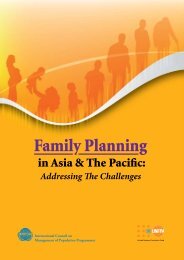Inter-lInkages between PoPulatIon DynamIcs anD DeveloPment In ...
Inter-lInkages between PoPulatIon DynamIcs anD DeveloPment In ...
Inter-lInkages between PoPulatIon DynamIcs anD DeveloPment In ...
You also want an ePaper? Increase the reach of your titles
YUMPU automatically turns print PDFs into web optimized ePapers that Google loves.
stop crisis centre in Dhaka and other regional administrative headquarters; and (v) hotline for women vulnerableto acts of violence. The Government in partnership with UNFPA is currently implementing the Promotion ofGender Equality and Women’s Empowerment, 2006-2010 Project under the Department of Women’s Affairs,Ministry of Women and Children’s Affairs. The project aims to have societal changes to reduce discriminatorypractices and to pursue equity and to empower women and girls to make decisions about their RH and rights.Nonetheless, a greater sense of urgency is needed in addressing VAW as it would delay the achievement of thehealth and gender-related MDGs.HIV/AIDS<strong>In</strong> Bangladesh, the HIV/AIDS prevalence is considered low. Despite that high risk behaviours such as IDU andunsafe sex could accelerate HIV transmission among key populations with higher risk of HIV exposure to its generalpopulation. Surveys show that HIV cases among IDUs increased markedly from 1.7% in 2000 to 4.0% in 2002.HIV/AIDS is only mentioned broadly in the PRSP 2, in terms of maintaining the HIV/AIDS prevalence levelbelow 1.0%. The NSP for HIV/AIDS 2004-2010 was developed by the National AIDS/STD Programme toprovide a comprehensive strategy for combating HIV/AIDS. The objectives in the NSP include:• Conducting research studies to understand the problem and establish baseline data for programme planningand evaluation;• Ensuring access to prophylaxis and protective services;• Generating political support for the national response to HIV/AIDS;• Reducing the vulnerability of youth;• Promoting family communication about HIV/AIDS;• Promoting safe practices in the health care system; and• Providing care and support services to people living with HIV and AIDS.Though the NSP provides a comprehensive and integrated action in response to HIV/AIDS, nevertheless, thechallenge remains on how key sectors could give priority to and coverage of HIV/AIDS as well as collaborateand coordinate among sectors in order that HIV/AIDS is treated as a development and not just a healthproblem. There is also a need to articulate the inter-linkages of population dynamics and development toaddress the potential spread within the high risk high/vulnerable populations to the general population.Natural DisasterAs one of the world’s most disaster prone countries, Bangladesh faces increasingly frequent natural disasterssuch as drought, floods, river erosions, cyclones, tidal waves, earthquake and Tsunami. With its fragile ecologicalsituation and compounded with increasing population and climatic change the situation will only worsen.The impacts on the population and country’s development are numerous and very devastating:• Death of citizens during the occurrence and aftermath - due to outbreaks of various diseases - of thenatural disaster;• Disability among people making them liabilities to their families and community and this adds to poverty;• Distress and misery among the population, both physically and physiologically;• Destructions of properties - houses, land, water bodies, trees and forests, crops, livestock, householditems - which pull people below poverty level; and• Destruction of infrastructure making it more difficult for victims to receive relief, rehabilitation and rebuildtheir lives.Since mid-1999, the Government of Bangladesh in collaboration with development partners has adopted a morecomprehensive disaster management programme to address the issue. The current three key strategies comprise:• Risk reduction first - the public sector partnering with the community and NGOs to reduce the risk of disaster;• Mitigation - the public sector to strengthen the mitigation capacity of the community and NGOs; and• <strong>In</strong>creased coordination - optimum coordination and best utilisation of resources as well as communityparticipation to increase their awareness on what they can do for protecting their lives and property.The challenge would encompass articulating the inter-linkages of population dynamics and development toaddress natural disaster, in terms of population displacement; gender sensitive coping mechanism as women34














